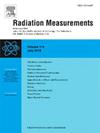室内空间分布式物联网氡监测:利用多节点Si-PIN阵列量化空间梯度
IF 2.2
3区 物理与天体物理
Q2 NUCLEAR SCIENCE & TECHNOLOGY
引用次数: 0
摘要
室内氡气暴露是公众电离辐射的主要来源,其空间分布极不均匀。然而,传统的单点监测设备难以捕捉梯度变化,而且高成本限制了大规模部署。本研究开发了一种基于物联网(IoT)的分布式氡监测系统(DRMS),通过集成低成本硅基(Si-PIN)传感器阵列和自适应抗干扰Zigbee网络,实现高分辨率空间监测。系统采用多个氡浓度传感器增强灵敏度,构建星团混合拓扑无线网络,保证了在复杂环境下(视距1000m和非视距300m)的可靠通信。实验验证表明,DRMS与标准氡探测器RAD7 (Durridge Company Inc., USA)在100-300 Bq.m−3的动态范围内具有良好的时间一致性。在封闭空间内可捕获高达4.27倍的氡浓度空间梯度(例如,中位数为228.5 Bq)。角落区域的m−3比53.5 Bq。m−3在近窗区域),这与计算流体力学(CFD)模拟结果相匹配(R2 = 0.962)。该系统为矿山、地下室等复杂环境的氡风险评估提供了一种经济高效的精确工具,对实现氡暴露风险的精准防控和公众健康保护具有重要价值。本文章由计算机程序翻译,如有差异,请以英文原文为准。
Distributed IoT-based radon monitoring in indoor spaces: Quantifying spatial gradients using multi-node Si-PIN arrays
Indoor radon gas exposure is a major source of ionizing radiation for the public, and its spatial distribution is highly heterogeneous. However, traditional single-point monitoring devices struggle to capture gradient changes, and high costs restrict large-scale deployment. This study developed an Internet of Things (IoT)-based Distributed Radon Monitoring System (DRMS) to achieve high-resolution spatial monitoring by integrating low-cost silicon-based (Si-PIN) sensor arrays with adaptive anti-jamming Zigbee networks. The system employs multiple radon concentration sensors to enhance sensitivity and constructs a star-cluster hybrid topology wireless network, ensuring reliable communication in complex environments (1000 m in line-of-sight and 300 m in non-line-of-sight). Experimental validation shows that DRMS demonstrates good temporal consistency with the standard radon detector RAD7 (Durridge Company Inc., USA) within the dynamic range of 100–300 Bq.m−3. It can capture spatial gradients of radon concentration up to 4.27 times in enclosed spaces (e.g., median value of 228.5 Bq.m−3 in corner areas vs. 53.5 Bq.m−3 in near-window areas), which matches the results of computational fluid dynamics (CFD) simulations (R2 = 0.962). The system provides a cost-effective and precise tool for radon risk assessment in complex environments such as mines and basements, holding significant value for achieving precise prevention and control of radon exposure risks and public health protection.
求助全文
通过发布文献求助,成功后即可免费获取论文全文。
去求助
来源期刊

Radiation Measurements
工程技术-核科学技术
CiteScore
4.10
自引率
20.00%
发文量
116
审稿时长
48 days
期刊介绍:
The journal seeks to publish papers that present advances in the following areas: spontaneous and stimulated luminescence (including scintillating materials, thermoluminescence, and optically stimulated luminescence); electron spin resonance of natural and synthetic materials; the physics, design and performance of radiation measurements (including computational modelling such as electronic transport simulations); the novel basic aspects of radiation measurement in medical physics. Studies of energy-transfer phenomena, track physics and microdosimetry are also of interest to the journal.
Applications relevant to the journal, particularly where they present novel detection techniques, novel analytical approaches or novel materials, include: personal dosimetry (including dosimetric quantities, active/electronic and passive monitoring techniques for photon, neutron and charged-particle exposures); environmental dosimetry (including methodological advances and predictive models related to radon, but generally excluding local survey results of radon where the main aim is to establish the radiation risk to populations); cosmic and high-energy radiation measurements (including dosimetry, space radiation effects, and single event upsets); dosimetry-based archaeological and Quaternary dating; dosimetry-based approaches to thermochronometry; accident and retrospective dosimetry (including activation detectors), and dosimetry and measurements related to medical applications.
 求助内容:
求助内容: 应助结果提醒方式:
应助结果提醒方式:


